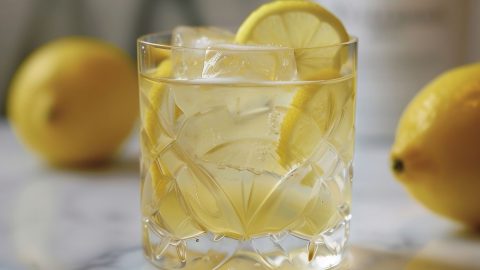


Gin lovers will adore the White Negroni! It’s a riff on the classic made with your favorite spirit.
Also called Negroni Bianco, it’s one of the most complex 3-ingredient cocktails around.
Made with gin, Lillet Blanc, and Suze, this Italian favorite features a delightful French twist.

What Is the Difference Between Red and White Negroni?
The White Negroni is a modern twist on the classic Red Negroni.
The main difference is, of course, the color. But it’s how you get that color that counts!
The White Negroni features gin, Lillet Blanc (a French aromatized wine), and Suze (a French brand of bitters).
The Red Negroni, however, features gin, Campari (an Italian liqueur), and sweet vermouth (fortified wine).
Both versions are bitter. But the White Negroni is more floral and crisp with a hint of sweetness.
Dating back to the early 20th century, the classic Negroni is an Italian invention. And one with many variations.
This version was invented in 2001 by Wayne Collins at the VinExpo in Bordeaux, France. If you like gin, it’s a must-try!

Ingredients
You only need three ingredients to make the White Negroni. But they’re not your everyday cocktail mixers.
So, if you’re not an avid mixologist, you might need to find a well-stocked liquor store or look online.
Here’s what you need for this White Negroni recipe:
- Gin – The herbal botanicals and aromatics shine in this drink. Choose a quality London dry gin for the best flavor.
- Lillet Blanc – A French wine and aperitif. It’s a little sweet, floral, crisp, light, and refreshing.
- Suze – A bitter liqueur and French aperitif. I use Suze Gentian Liqueur, which is flavored with gentian root. It’s sweet, citrusy, and bitter, with notes of vanilla and candied orange.
- Lemon Twist – For a garnish. It’s classy and adds a complementary citrusy component.
How to Make a White Negroni Cocktail
Like the classic Negroni, the White Negroni is easy to make. And like the Toronto cocktail, it doesn’t even need a cocktail shaker.
Instead, all you need is a glass, a strainer, and these steps:
1. Pour the gin, Lillet Blanc, and Suze into a glass filled with ice, then stir gently.
2. Strain the cocktail into a fresh glass with new ice.
3. Garnish with a lemon twist. Serve and sip!

Recipe Variations and Substitutions
The three-ingredient White Negroni is an easy cocktail to mix up. But the lesser-known ingredients make it more challenging for beginners.
To help you out, I’ve included some variations and substitutions. That way, you can make the best White Negroni!
Variations
Whether you can’t find a certain ingredient, or just want to switch things up, I have you covered!
White Negroni Sour: Shake 1 1/4 oz gin with 1 1/2 oz blanc quinquina (a Corsican aperitif), 3/4 oz Suze, 1/2 oz simple syrup, 3/4 oz lemon juice, and 7 drops Ms. Better’s Bitters Miraculous Foamer.
Harrison Ginsberg’s White Negroni: Directly from the bartending pro himself! Combine 1 oz gin with 1 oz Cocchi Americano, 3/4 oz Suze, and 1 tsp Verjus Blanc.
Mezcal Negroni: Based on a classic Negroni, this version features mezcal, Campari, and sweet vermouth (1 oz each). It’s smoky and complex.
Sparkling White Negroni: Top off the cocktail with Champagne or Prosecco for a fizzy and refreshing drink.
Substitutions
The key thing when substituting in cocktails is to do so sparingly.
For the best taste, use the brands listed in the recipe. But if you have to make substitutions, only swap one of the three ingredients.
Otherwise, the drink won’t taste like it should.
That said, here are my top choices for swaps in the White Negroni:
What Is a Substitute for Suze in A White Negroni?
Cocchi Americano is my top recommendation. It’s a quinine-flavored Italian fortified wine that will actually make the drink white.
Luxardo Bitter Bianco, Salers, and Bianco Vermouth are other options, too.
What Gin Is Best for A White Negroni?
A high-quality London dry gin is best. This style is juniper-forward and unsweetened.
A few recommendations include Beefeater, Plymouth, and Bombay Sapphire.
What Is a Good Substitute for Lillet Blanc?
Cocchi Americano is also a substitute for Lillet Blanc.
Other fortified wines, such as Dolin Blanc Vermouth, and Kina L’Aéro d’Or, also work well.

More Gin Cocktail Recipes To Try
Bramble
The Last Word
Gibson Cocktail
Dirty Martini
White Negroni
1
servings5
minutes199
kcalGin lovers will adore this White Negroni cocktail! It’s a riff on the classic made with gin, Lillet Blanc, and Suze, so it’s crisp, floral, and refreshing.
Ingredients
1 1/2 ounces gin
1 ounce Lillet Blanc
1/2 ounce Suze gentian liqueur
lemon twist, for garnish
Instructions
- Add the gin, Lillet Blanc, and Suze to a mixing glass filled with ice. Stir gently.
- Strain the cocktail into a rocks glass with fresh ice.
- Garnish with a lemon twist. Serve and enjoy!
Notes
- Suze is a French herbal liqueur with a distinct bitter and earthy flavor from gentian root. Adjust the amount to your taste, as its bitterness can be quite pronounced.
- For a festive touch, top your White Negroni with a splash of chilled Prosecco or Champagne.
Did you like the recipe?
Click on a star to rate it!
Average rating 5 / 5. Vote count: 1
No votes so far! Be the first to rate this post.
We are sorry that this post was not useful for you!
Let us improve this post!
Tell us how we can improve this post?


















